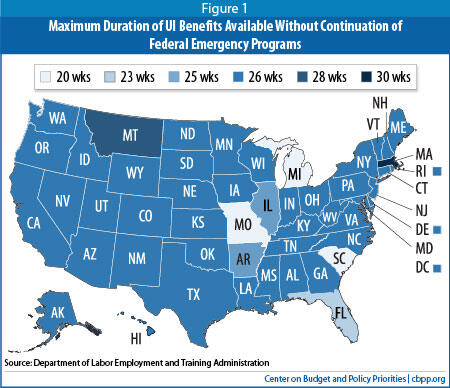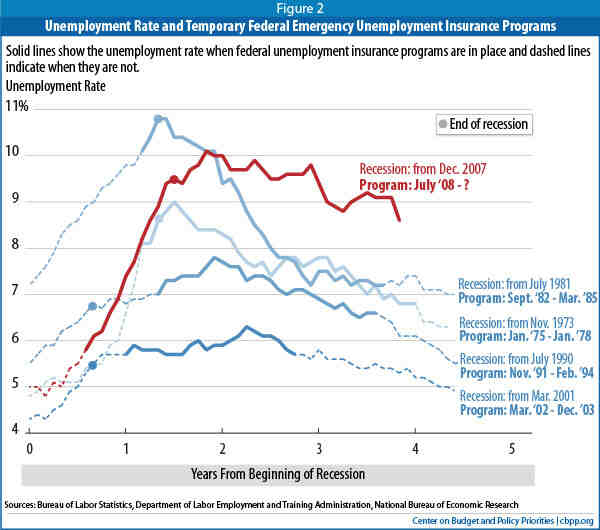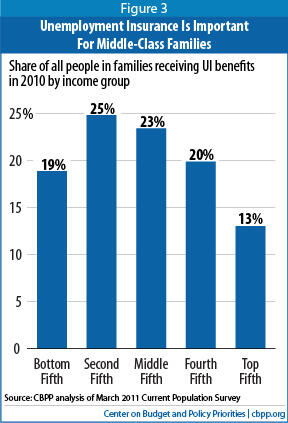In the heat of the battle over how to address the imminent expiration of federal emergency unemployment insurance (UI) benefits (and the payroll tax cut), policymakers should not lose sight of what UI is and how it has functioned over the years. UI not only cushions the financial blow for workers who lose their jobs through no fault of their own but also helps sustain consumer demand during economic downturns by providing a continuing stream of dollars for families to spend.
The federal-state unemployment insurance system helps people who have lost their jobs and are eligible for benefits by temporarily replacing part of their lost wages.[1] Created in 1935, UI is a form of social insurance in which employers pay taxes (which economists believe are financed by reductions in their employees' compensation) into the UI system and states use those funds to provide income support to workers and their families if they lose their jobs.
To qualify for UI benefits, a person must have lost a job through no fault of his or her own and be ready, willing, and able to take a "suitable" new job. Unemployment insurance does not cover people who leave a job voluntarily, people looking for their first job, or re-entrants who previously left the labor force voluntarily. For the past 25 years, fewer than half of unemployed workers have actually received unemployment insurance, except during recessions.[2]
The average unemployment benefit is about $300 per week. However, individual benefit levels vary greatly depending on the state and the worker's previous earnings. State laws typically aim to replace about half of a worker's previous earnings up to a maximum benefit level. Because the benefit is capped, UI benefits replace a smaller share of previous earnings for higher-wage workers than lower-wage workers. [3]
The total number of weeks of benefits available in any particular state depends on the unemployment rate and unemployment insurance laws in the state where the person worked.[4] Workers are eligible for up to 26 weeks of benefits from the regular, state-funded UI program in most states.[5]
In the current downturn, workers in any state who exhaust their regular UI benefits before they can find a job can receive up to 34 additional weeks of benefits through the temporary federal Emergency Unemployment Compensation (EUC) program enacted in 2008. [6] That number rises to 53 weeks in states with especially high unemployment rates. Workers who exhaust their regular UI and EUC benefits can receive up to 20 additional weeks of benefits through the permanent federal-state Extended Benefits (EB) program if their state's unemployment insurance laws allow it.
EUC is scheduled to expire on January 3 — even though over two-fifths of the unemployed have been looking for a job for more than 26 weeks. Also scheduled to expire is full federal funding for the permanent EB program, whose cost is typically shared 50-50 between the states and the federal government.
[7] Full federal funding for EB, which Congress enacted in the Recovery Act, allowed many states to temporarily expand their programs.
With the unemployment rate expected to remain above 8 percent through next year,[8] the fundamental question that Congress is debating is whether to continue these emergency federal UI programs.
If Congress does not extend these federal programs before the holidays, all federal UI benefits will end, and the number of weeks available in the rest of the states will shrink significantly (see Figure 1). Most of the several hundred thousand workers who exhaust their regular state benefits each month would receive no further help. The Administration estimates that up to 6 million individuals would lose benefits over the course of 2012.
The problem for most businesses in an economic slump is not that they don't have enough capacity to meet existing demand but that they don't have enough demand to fully utilize their existing capacity. Thus, policies that put customers in the stores with money to spend are likely to be more successful at closing the output gap and creating jobs than giving businesses tax breaks.
As the Congressional Budget Office has explained, unemployment insurance "adds to overall demand and raises employment over what it otherwise would have been during periods of economic weakness."[9] UI benefits are targeted on workers who are involuntarily unemployed and whose income has fallen, a group that tends to be concentrated in the areas and industries most affected by a slowdown. Supporting spending by unemployed workers in hard-pressed communities helps prevent the spread of layoffs and job losses in those communities.
This is why CBO consistently ranks assistance for unemployed workers as one of the most effective policies for generating economic growth and creating jobs — CBO rated it first among the 11 spending and tax measures evaluated in a recent report.[10] Mark Zandi, chief economist of Moody's Analytics, estimates that each dollar of UI benefits generates $1.55 in new economic activity in the first year.
A Labor Department report released last year (originally commissioned during the Bush Administration) reinforces CBO's conclusion. It found that in the depths of the recession, federal emergency UI benefits boosted employment by about 750,000 jobs. [11] (Regular, state-funded UI benefits boosted employment by an additional 1 million jobs.)
Failure to extend the federal unemployment programs would mean less spending by unemployed workers and their families, which would hurt sales at local businesses and undermine job creation in an already weak recovery. Effective temporary stimulus measures like emergency UI benefits can give the economic recovery a much needed boost and reduce the risk of sliding back into recession.
Congress has created a program to provide additional weeks of UI benefits in every major recession since the 1950s. The reason is simple: job opportunities are scarce in a weak economy and it can take jobless workers longer than the 26 weeks that state UI programs typically provide to find a job, no matter how hard they are looking.
These federal programs have always been temporary, ending when the economy is back on track and job opportunities are starting to open up — but not before then.
Basic economics tells us that we're still far away from that point, which means it would be a serious mistake to let the current programs expire on January 3rd. Finding a job remains extremely difficult: in October, about 14 million people were competing for about 3 million job openings. That means that even if every job opening were instantly filled with an unemployed worker, three out of four unemployed workers would still be looking for a job. Over 40 percent of the unemployed have been looking for a job for more than 26 weeks, half of them for over a year, according to the Pew Economic Policy Group.[12] We still have a long way to climb out of the huge jobs hole that the recession created. Allowing the federal programs to expire now, while the economy is underperforming, would be like taking our foot off the gas pedal just as we're trying to restart the economic engine.
As Figure 2 illustrates, the highest unemployment rate at which federal unemployment benefits have ended in previous recessions was 7.2 percent (in March 1985). November's unemployment rate was 8.6 percent.
Opponents of continuing emergency unemployment benefits often assert that UI discourages people from looking for work and that ending these benefits would speed a return to full employment. Though research from earlier periods showed that additional weeks of unemployment insurance have an impact in lengthening unemployment spells, the most careful recent research indicates that these concerns are overblown. [13]
Additional weeks of UI benefits have three distinct effects on the duration of unemployment spells. First, unemployment insurance has the beneficial effect of allowing an otherwise financially strapped unemployed worker to search more efficiently for an appropriate job (rather than having to accept the first job offered, whether or not it is a good match for his or her skills). Second, since unemployed workers are required to seek work in order to qualify for UI benefits, additional weeks of UI benefits keep unemployed workers attached to the labor force and looking for jobs for longer than they might have without those benefits. Finally, UI creates minor disincentives to look hard for a job.
One study released in early 2010 offers the "back of the envelope calculation," based on the relevant research, that weeks of benefits added through EUC could account for "between 0.7 and 1.8 percentage points of the 5.5-percentage-point rise in the unemployment rate." [14] But it also suggested that "the true effect of extended UI benefits on unemployment duration is likely to be at the lower end of these estimates."
Indeed, a careful study of recent evidence by economist Jesse Rothstein (former chief economist at the Labor Department) found that federal extensions of UI in the past few years likely had an even smaller effect than this. Rothstein found that the unemployment rate in December 2010 would have been only about 0.2 percentage points lower without the extension of unemployment compensation. [15] Moreover, Rothstein also found that at least half of this 0.2 percentage-point increase could be from increasing labor force attachment — i.e. keeping UI recipients actively searching for work rather than dropping out of the labor force. Most other studies of the disincentive effect of UI in the current downturn have also found relatively small effects.
Harvard economist Lawrence Katz has also observed that traditional estimates of the relationship between UI and the length of unemployment spells ignore other effects, such as "the macroeconomic stimulus impacts of increased consumption expenditures by the unemployed … as well as the gains from keeping more of the long-term unemployed attached to the labor market rather than moving onto disability programs." [16]
Arguments that emergency UI benefits are an important contributor to high unemployment in today's economy have cause and effect backwards. We have a temporary federal program because unemployment is so high and jobs are so hard to find. When there are four unemployed workers for every job opening, it is hard to see how sharply curtailing the duration of unemployment insurance benefits would increase the pace of job creation.
Unemployment insurance has kept millions of people out of poverty in each of the past few years. CBPP analysis finds that the UI system kept 4.6 million people out of poverty in 2010 — 3.2 million of them as a result of the federal emergency UI benefits that Congress is debating whether to continue.
[17]As critical as UI is for many families near the poverty line, it is also a bedrock middle-class program. Analysis of recent Census data shows that nearly 70 percent of the families who received UI during 2010 had incomes in the middle 60 percent of the income distribution (see Figure 3).
A CBO analysis released last year found that the median income of families receiving UI benefits was $54,800 in 2009. [18] The median income of families receiving UI who had been unemployed for more than 26 weeks — those households who will not have access to any federal unemployment benefits in most states if Congress allows the emergency programs to expire — was slightly lower at $49,000, but close to the middle of the income distribution.
CBO also found that workers in families with incomes of more than twice the federal poverty line (about $44,000 for a family of four in 2009) were more than twice as likely to receive UI benefits during spells of unemployment than workers in families below the poverty line.
If Congress fails to continue the federal UI programs, 1.8 million workers will miss out on federal unemployment benefits in January, according to the National Employment Law Project (NELP).[19] The Administration projects that this number will rise to 6 million over the course of 2012.
NELP's estimate of 1.8 million workers affected in January includes:
- Over 430,000 workers who will exhaust their regular state benefits in January and won't have access to any federal benefits. Several hundred thousand unemployed workers exhaust their regular benefits each month — a trend that will continue over the coming year.
- Almost 650,000 workers receiving EB benefits who will lose those benefits immediately because their states will end their EB program when full federal funding expires.
- Over 700,000 workers receiving EUC benefits who will lose those benefits prematurely. EUC provides benefits in "tiers" of weeks; people receiving EUC as of January 3rd will be allowed to complete their current tier but not move on to the next tier.[20] NELP estimates that over 700,000 workers will reach the end of their current tier and thus receive no further federal benefits in January. Many more will lose EUC benefits prematurely in the months to follow.




